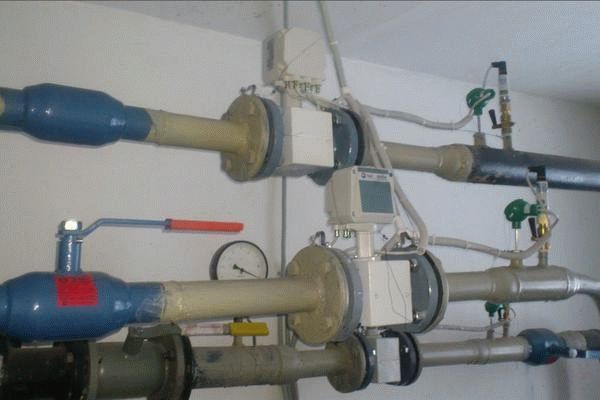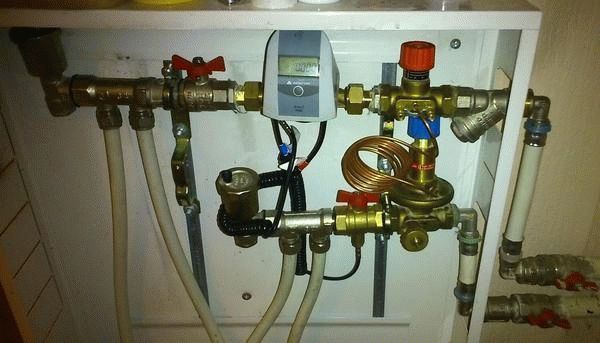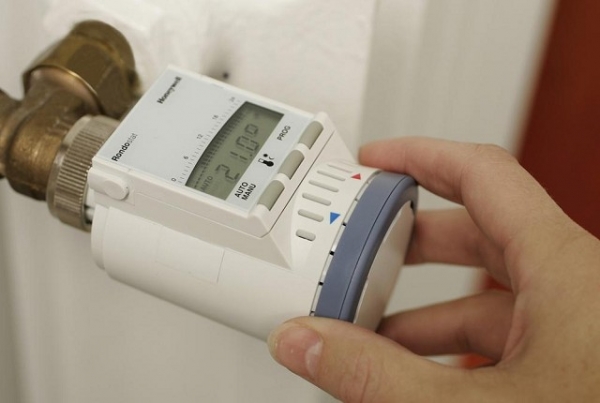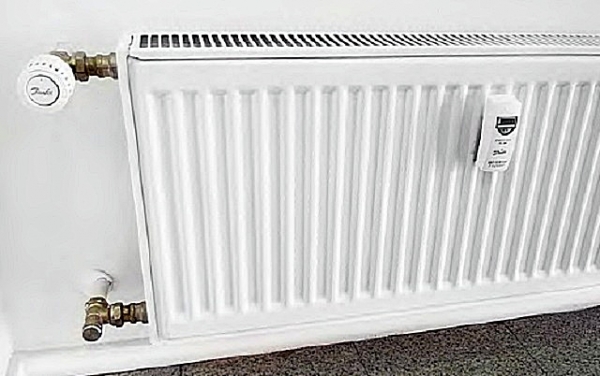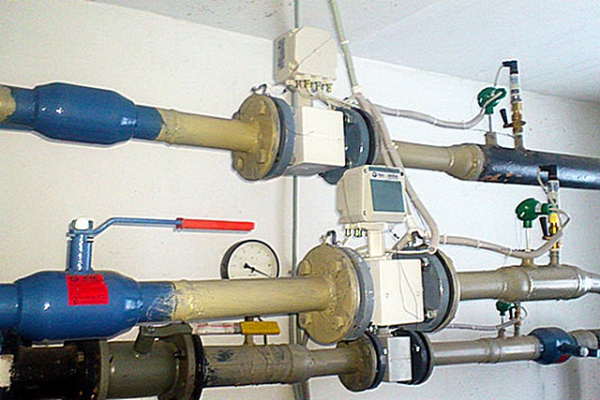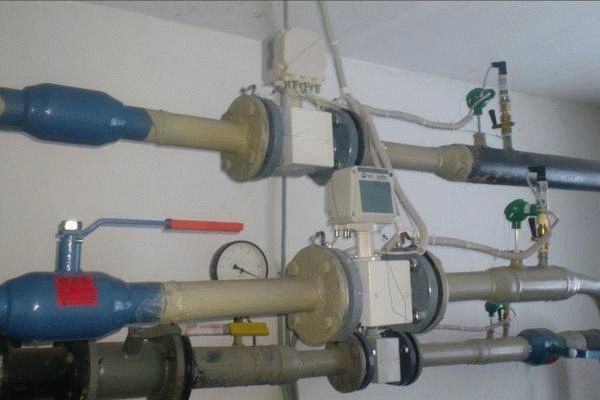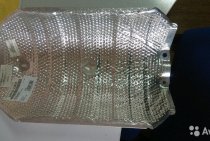How much does a common house heat meter cost
The cost of installing a heat distribution system for owners of premises in an apartment building consists of the following items:
- the cost of the meter itself and related materials;
- expenses for the development of project documentation and documents containing the technical conditions of the heat supply system, without which the installation cannot be carried out;
- the cost of installation work, including commissioning.
Prices for meters depend on the manufacturer and type of device:
- ultrasonic - the most expensive counter in the price range from 15 to 50 thousand rubles;
- electromagnetic costs 15-17 thousand rubles;
- vortex will cost an average of 15 thousand rubles;
- tachometric is the most inexpensive option with a service life of no more than 4 years, its price is from 6 to 10 thousand rubles.
As a result, the amount of all activities can range from 150 to 300 thousand rubles, which residents can pay off at a time, in installments or at the expense of funds collected for major repairs.
How not to pay for the installation of a common house meter
Installing a meter can cost residents free of charge if the management company or HOA that manages the house enters into an agreement with an energy service company (ESC). Then the metering device will be installed at its expense and transferred to the owners of MKD for a while on lease.
In fact, such a mechanism involves covering the expenses of the energy service company for the installation of the meter (with a planned profit) gradually, with the subsequent transfer of it to the tenants. The process is as follows:
- UK or HOA enter into an agreement with the ESC.
- ESC installs a common house heat meter from its own funds.
- Residents of the house pay for heat according to the meter and transfer 80% of the existing savings to pay off the cost of its installation;
- After a full refund of ESC costs, the metering device is transferred to the tenants in the property.
For example, prior to the installation of a heat distribution system, the owners of the premises of the house paid 620 thousand rubles. After installation, the costs were reduced by 80 thousand rubles a month, which we will consider savings. Of this amount, 64 thousand rubles. (80% of the savings) tenants will be able to pay monthly to cover the costs associated with installing the meter.
The energy service company invested 284 thousand rubles in equipping the house with a metering device. rubles plus, under the terms of the contract, the expected profit will be 86 thousand rubles. Accordingly, after 6 months, a full payment will be made and the meter will be transferred to the residents of the MKD.
Installation taking into account the legislative framework FZ-261
The main document on the installation and use of general house meters is the Federal Law of November 23, 2009 No. 261-FZ “On Energy Saving and Improving Energy Efficiency and on Amending Certain Legislative Acts of the Russian Federation”.
According to the law, only organizations supplying energy resources and specialized equipment can install a meter. Such organizations must be members of the SRO in construction and have a SRO certificate of admission to this type of work.
Install a meter at the entrance of communications to the territory of the house. The invisible line separating the territory of house management is called the boundary of operational responsibility. Possible heat losses at the meter installation site are calculated and entered into the heat supply contract. Like other metering devices, general house heat meters are sealed, it is impossible to change their settings just like that.
Installing a meter requires professionalism, so choose contractors carefully: check their licenses and certificates, read reviews.Our company performs all work related to accounting for thermal energy: we conduct energy audits, develop projects, select equipment and install it
Contact us for advice or installation of flowmeters!
Subscribe to our newsletter and be one of the first to know all our news!
Calculation of tariffs for services in public places
Public areas include the following:
- Basement.
- Entrance.
- Flights and staircases.
- All kinds of storerooms.
If we are talking about communal apartments, which are still found, then such areas as a bathroom, kitchen and corridor are added to this list. In other words, this is absolutely any place where all the owners living nearby get access.
Such objects, as you know, are illuminated, heated, and payment is distributed to all owners. Calculations for such "public" services are carried out according to a special formula with indicators such as:
- C (total) - payment for the service provided in public places.
- P - parameters of common house appliances.
- T - the tariff for services that is relevant for a certain area.
- C (ind) - the payment of each tenant according to individual meters.
The calculation formula looks like this - the amount of the resource provided is divided by the amount consumed, recorded in the installed counters.
The result calculated in the course of calculations in kilowatts or in cubic meters is translated into a sum of money, which must be paid by all residents. It is it that is divided into all owners of residential premises.
Types of general house heat meters
Only a specialist can pick up a common house meter. Although the devices perform the same function, the principle of their operation is different, and therefore the installation rules are also different. There are four types of general house heat meters:
- Tachometric. Simple and inexpensive, they use mechanical water meters and heat meters. If the water is hard, the filters of the devices will constantly become clogged, and the pressure of the coolant will decrease. But due to the lack of electronics, these devices operate at high dampness and humidity. Therefore, tachometric instruments are installed in the private sector.
- Electromagnetic. Inexpensive but accurate meters suitable for homes with good water quality. Metal impurities in the water distort the readings of the instruments, and not in favor of the residents, so the owners overpay.
- Vortex. One of the advantages of this type of heat meters is that they are installed on horizontal and vertical sections of the pipeline. They work accurately in any conditions, and readings can be taken remotely via the air interface.
- Ultrasonic. The most accurate type of equipment, but they are sensitive to water quality.
Why do you need a common house meter
A common house metering device allows you to control the actual consumption of a resource within a house and record the actual volumes of the delivered resource - water, electricity, gas and heat. That is why, first of all, the LRTC is established in order not to overpay for the amount of losses on the backbone networks of the supplier.
Utility costs are formed by 2 factors: the amount of resource consumed and approved tariffs. Tariffs for housing and communal services are growing every six months, and the consumer has no opportunity to influence their growth. Nevertheless, by influencing the second factor - the volume of the resource consumed, the management company and apartment owners have a real opportunity to save costs.
Installation of ODPU allows:
- pay for the consumption of the resource after the fact; to distinguish between losses for losses on backbone networks between RSO and owners; fix the loss of resources.
Thus, the presence of an HLR is the only way to determine the real consumption of resources in a house.
Do I need a common house meter if the apartments have individual metering devices
If individual metering devices (IPU) are installed in the apartments, the owners pay for what they actually consumed. However, in addition to individual consumption, in receipts for payment for communal resources, there is also a general house expense (ODN).
Ideally, the category of common house expenses should include resource consumption for servicing common house areas. But in practice, this category includes the entire resource that was not taken into account by individual metering devices - including all kinds of leaks. As a result, the volume of the resource written off in the ODN column can grow to anomalous sizes of 30% of individual consumption and more. While "normal" is considered ODN, not exceeding 1.5-2%.
In the absence of a common house meter, it is impossible to determine where the leaks are. They can be both in the system of the house itself, and in networks from the resource organization to the house.
The presence of general house accounting makes it possible to pay only for the resource that was actually delivered to the house.
In itself, the presence of a common house meter does not save you from an overestimated ODN - there are still leaks inside the house itself and about a dozen more reasons that affect the growth of this expense item.
However, the installation of a common house meter is the first step towards reducing costs.
In which houses is it necessary to install a common house metering device
The installation of common house meters depends on the degree of improvement of the house. Common house water, electricity, gas and heat meters must be in houses connected to centralized power supply networks, as well as to systems:
- district heating; centralized water supply; centralized gas supply; other systems of centralized supply of energy resources.
At the same time, such requirements do not apply to dilapidated, emergency facilities, and to facilities in which:
- power consumption of electrical energy is less than 5 kWh; the maximum volume of heat energy consumption is less than two tenths of Gcal/h; the maximum consumption of natural gas is less than 2 m³/h.
Varieties of common house heat meters
Different devices have a different principle of operation, installation and maintenance. It is best to provide a choice of the optimal variant of the organization for the installation of such equipment. Specialists will assess the condition of the house and, based on this, provide the necessary type of heat meter.
Varieties of heat meters:
- Tachometric;
- Ultrasonic;
- Electromagnetic;
- Vortex.
Tachometric meters are simple designs that have a mechanical rotary or vane water meter and a heat calculator. The price of the device is affordable. It is mandatory to install a magnetic-mechanical filter.
Such a device does not work well with high water hardness. That is why such options are used in a private house. A significant plus of the system is battery life, which lasts for 5-6 years.
Electromagnetic heat meters in their work use an electromagnetic field. When the volume of the coolant changes at the inlet and outlet, a small current arises. Strict rules are put forward for the installation of such equipment, with which qualified workers are familiar.
Vortex heat meters operate on the principle of the occurrence of vortices behind obstacles that are in the path of the coolant. Suitable for installation on any wiring. The main thing is a straight section of pipes before and after installation of the device.
The ultrasonic variety works on the principle of the passage of ultrasound through a coolant. The ideal place to install such mechanisms is new houses with a clean flow of water. Such heat meters are too sensitive to any extra parts in the liquid.
What are the types of devices
Each heat meter is a complex of devices, which includes sensors, units responsible for recording the consumed heat, and all kinds of converters that work with pressure, flow and resistance indicators of the heat carrier.
The manufacturer installs the complete set of the counter and they differ depending on the model. The most common are ultrasonic and mechanical devices, while vortex and electromagnetic devices are practically unpopular due to their complexity and high cost.
There are also calculators and distributors of thermal energy that do not need to be built into the thermal circuit; such devices can be used with absolutely any circuits.
| A type | Peculiarities |
| Mechanical | The simplest of the types of construction, therefore, its price is quite low and is at the level of 9-10 thousand rubles. This is a device with wired temperature sensors, a water meter and an electronic unit. A working element is a part that rotates when the coolant passes through the device, and it is the number of revolutions that sets the volume that has passed through the device. Two thermometers are placed on the supply and return pipes, and this can be done both vertically and horizontally |
| Ultrasonic | The amount of media consumed in this type of device determines the ultrasonic signal due to the emitter and receiver, while they are mounted on a horizontal pipe, but with a certain distance. The emitter signal travels through the water and reaches the receiver, and the time is calculated by the speed of the water in the circuit. Ultrasonic samples can regulate the flow in some variations, but this is the lot of advanced models. |
| Calculators and distributors | These instruments measure relative heat inputs and consist of thermal adapters and two sensors. Once every three minutes, the sensors measure the temperature, being installed on the battery and in the room, while displaying the difference in values. The information received is shown on the display. These devices are programmed in advance for the coefficients and power of the radiator, and as a result, the heat consumption indicator will be displayed in kilowatt-hours |
The principle of operation of the heat meter
The heat meter has a wide range of functions. It allows you to determine the period of time for the operation of devices, which is indicated on a specific metering station. It also indicates the temperature of the coolant. But the main thing is fixing the amount of heat energy consumed.
The heat meter scheme includes:
- Thermal converters - temperature sensors;
- Calculator - calculates the amount of heat spent;
- Power supplies;
- A flow meter is a sensor for calculating volume.
The heat meter is used to register the received heat, which comes with the coolant. The amount of energy that is used by the device per hour is determined, the temperature of the liquid at the inlet and outlet and into the system is taken into account. This is how the temperature difference is determined for a certain time. For this, a special calculator is provided in the counter.
The necessary data is supplied by flow and temperature sensors. One temperature sensor must be installed in the supply pipeline of the system, and the second - in the outgoing one. The calculator analyzes the received data and displays the exact consumption figure on the screen.
The procedure for replacing and checking meters
Public appliances can be safely attributed to the standard public property belonging to all residents. It is for this reason that the entire team is responsible for all manipulations. Checking of such devices is carried out not by the owners, but by employees of the management company who have special qualifications.
Standard maintenance of meters consists of the following operations:
- Thorough inspection of the ODPU.
- Repair processes in case of detection of damage, wear or breakage of the entire device or its parts.
- Checking and reconciliation of the displayed figures with real ones.
Based on the results of the check, a special act is drawn up. It is signed by two parties, where one is an employee of the management company, who acts on behalf of the owners, the other party is the person who carried out the verification.
The act must reflect the grounds for deviation from predetermined indicators, as well as methods for their elimination. It is prescribed who is responsible for correcting the violations found.
If the installed devices are equipped with a special automatic system, the service provider is obliged to pay for this. Devices of such a plan are usually installed by suppliers at their own expense. Residents should not interfere with this process.
Is it possible to save on heating at all?
From the above information, we can conclude that a common house meter does not provide obvious benefits for residents. However, there are ways that will help save money - these are individual heat meters installed in combination with thermostatic control devices for heating radiators.
Having such a device, you can independently control and regulate the heat supplied to the premises. In addition, if metering and thermal control devices are installed in all apartments of the house, this will allow their owners to depend less on each other.
- An individual meter is mounted at the entrance of the heating pipes to the apartment. The meter must be sealed by representatives of the organization controlling the heat supply, otherwise its readings will be considered invalid.
- Thermostatic regulators are installed at the heating radiator inlets. A simplified version is throttles (ordinary or specially designed cranes). thermostats. of course, they are more expensive, but they make it easier to precisely control the temperature of each of the radiators individually. Thus, it is possible to achieve a comfortable temperature in the premises and not suffer from the heat by opening the windows when it is + 10 ÷ 15 degrees outside, and utilities heat up, as at -20 ˚С.
The best option are digital or mechanical thermostats. The thermostat head is installed so that it is not exposed to the hot air rising from the heater. A special bellows device (expanding or decreasing in volume with a change in the air temperature in the room) acts on the thermal valve stem, which reduces or increases the cross section of the coolant passage to the radiator.
As mentioned above, if the radiators are connected to different heating risers, then metering devices will have to be installed on each riser. And it’s not at all a fact that they will be able to pay for themselves, since, in addition to buying, you will have to spend money on their maintenance, inspection and possible periodic repairs.
There is another way to account for the heat spent on heating an apartment - this is an electric thermometer that takes and records temperature readings from the surface of the radiator, as well as the air in the room. Such a device has a very affordable price, and it is easy to install it yourself - it is attached directly to the surface of the battery.
But such a device will in no way affect the payment for consumed heat - its readings have informational, but not official registration value. Having information about the operation of an individual radiator for a certain period, as well as the total costs of all radiators, one can only roughly estimate the heat costs for the entire apartment. This factor will be a good incentive to save or look for a “vulnerable spot” in the thermal insulation system in order to eliminate the heat leakage path that has appeared. Thanks to this, the overall heating costs can be significantly reduced.
But this increasingly applies to private houses or to individual heating systems in apartments.
Beneficial or not their installation
If you want to install this metering device or at the direct request of the management company, you need to understand whether this solution will be profitable, or installation does not make sense at all.
You need to understand that even if the device is installed, it will still be unprofitable with some nuances:
| If the heat main is introduced into the house according to the old scheme | Which provides for the presence of an elevator |
| The apartment is located either on the corner of the house, or on the first or last floors | What reduces the level of thermal insulation |
| There are gaps in the window frames, or there are gaps in the front door | What causes heat leaks |
| The balcony is not glazed | — |
| The entrance has free air circulation | For example, due to a non-functioning entrance door, or broken windows |
In order to minimize the consumption of thermal energy, it is necessary not only to install a common house meter and a device in the apartment, one should also take care of modernizing the heating system of the entire building, in particular, it is advisable to replace the elevator unit with AITP types, as well as AUU.
Only then, and with proper thermal insulation, it will be possible to make the presence of a meter effective and minimize utility bills.
Heat meters in apartment buildings can be installed in order to save money and improve the energy efficiency of buildings.
To do this, you need to coordinate this procedure with the management company, select a licensed organization for installation and take care of good thermal insulation. Only in this case, the installation of equipment will be legal and completely correct.
- Due to frequent changes in legislation, information sometimes becomes outdated faster than we can update it on the site.
- All cases are very individual and depend on many factors. Basic information does not guarantee the solution of your specific problems.
Therefore, FREE expert consultants are working for you around the clock!
APPLICATIONS AND CALLS ARE ACCEPTED 24/7 and 7 days a week.
- Due to frequent changes in legislation, information sometimes becomes outdated faster than we can update it on the site.
- All cases are very individual and depend on many factors. Basic information does not guarantee the solution of your specific problems.
Therefore, FREE expert consultants are working for you around the clock!
- Ask a question via the form (below) or via online chat
-
Call the hotline:
- Moscow and the Region — +7 (499) 113-16-28
- St. Petersburg and the region — +7 (812) 243-19-89
- Regions — 8 (800) 551-61-26
APPLICATIONS AND CALLS ARE ACCEPTED 24/7 and 7 days a week.
The order of registration and installation of the counter
So, in what sequence should the heating system of an apartment building be equipped with a meter if it was not installed immediately during construction.
The first step should be to hold a general house meeting - it is most often organized by representatives of the management company. At the meeting, a decision is made on the installation of a heat meter and the type of device is selected. Then representatives of the residents of the house or the management company apply to an organization with the appropriate authority and engaged in the supply and installation of heat meters.
Further work is carried out in the following order:
- A project is being drawn up to integrate the meter into the heating system of the house.
- The management company, having studied the draft, gives its consent to the installation work.
- Further, in accordance with the project, the device is installed in the system.
- After that, it is mandatory to test the operation of the device with the preparation of documentation from the installer company.
- In conclusion, a representative from the heat supply company is called, who seals the meter, draws up an act for its registration. And only after the official registration, the device becomes the basis for further calculations for the heat consumed by the house.
If all the above activities are not carried out, and the meter is not officially registered, then its data will not be considered legitimate, and will not be indicated in receipts for payment for heating.
Some factors affecting the operation of the device
During the operation of the meter, the quality of its work can be influenced by external factors, on which the accuracy of the readings taken sometimes depends.
The most common influencing factors today are:
- The high temperature of the coolant can partially or completely disable the metering device. Although, initially it was designed for such operating conditions. But sometimes the quality fails.
- The formation of scale on the inner walls of the pipeline reduces the diameter of the pipe, as a result, the passage of the water flow is difficult. In this regard, some counters stop giving real readings - as a rule, they change upwards.
- The lack of grounding of the pipeline leads to the formation of an electric charge inside the pipeline, which also causes errors in the meter readings.
- Contaminated coolant, as well as gas bubbles suspended in water, are a negative factor for all types of metering devices, as they affect the correctness of readings. To eliminate the occurrence of errors, it is necessary to install protective filters in front of the meter.
- Pressure drops in the heating system can also distort the meter readings.
- Layering of sediment in the cavity of the device itself. In the tachometric counter, the presence of sediment reduces the readings, while in all the others, on the contrary, it increases.
- Electronic equipment fails under the influence of high humidity and temperature changes in the room where the meter is installed.
It should be noted that all of the above points - the choice of a meter, control over its work, as well as negative factors affecting the accuracy of its readings, touch each of the residents of the house, affecting the amounts payable. Therefore, after the introduction of a heat meter into operation, all residents will have to be attentive to possible failures in the heating system, since they are likely to affect the meter readings. In case of problems, it is necessary to immediately call the specialists of the service company for preventive maintenance.
And what even a temporary failure of metering devices can lead to - the video clip brought to your attention very clearly shows:
The main types of ODPU
Modern devices are designed for the following types of resources provided:
Thermal energy - counters can be vortex, tachometric, electromagnetic and ultrasonic
The device allows you to save money on utility bills, which is especially important in the face of constantly rising prices. In some cases, a collective meter is installed, but only by decision of the general meeting of owners.
Electricity
Such devices can be multi-tariff and individual. The first allow you to save on energy consumption. The general principle of counting depends on the time of day. At hours from 7 to 10 in the morning and from From 17 to 21 in the evening, the user pays the maximum, during the rest of the hours at reduced rates.
Hot and cold water
It takes into account the amount of consumed volume based on the number of people who actually live in the apartment, and not registered.
Quite often, devices of this kind are used separately for cold and hot water, as well as for metering electricity and heat. The installation of the last two is carried out in special technical premises that are inaccessible to ordinary residents. It can be different basements and other utility rooms. Water meters are mounted directly in the apartment, on the corresponding pipes.
Who should put a common house meter for heating, the advantages of installation
Installation is carried out by specialists who are hired by the housing and communal services service at home. Tenants of an apartment building pay for the installation. A common house meter records the total amount of heat that enters the high-rise building. That is why it is worthwhile to understand in more detail the benefits of such a device.
Advantages of using a common house meter:
- You can save on equipment, since self-installation will be quite expensive. The cost of a common house appliance is shared among all tenants.
- Everyone will now use heat more carefully. Residents will be more responsible for open entrance doors or a damaged window.
The disadvantages include the high cost of the device. In this case, the device may fail, and the residents will again have to pay for its repair. But the main disadvantage is the inability to save on heating the apartment due to less consumption of thermal energy.
To calculate the heat consumed, the meter data is taken and divided by the area of \u200b\u200bthe room. Of course, there are certain benefits from installing such meters. Otherwise, the payment would take place at inflated coefficients. But at the same time, it is impossible to regulate the heat supply, which is a significant drawback.

